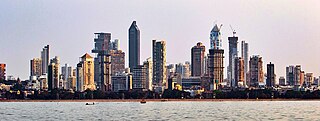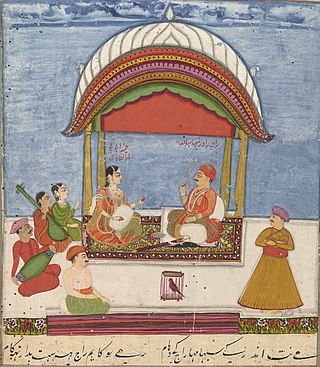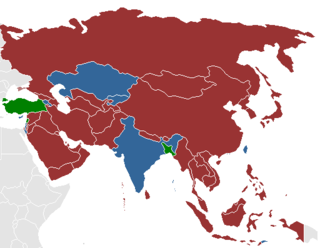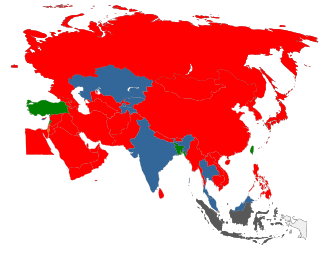Related Research Articles

Mumbai is the capital city of the Indian state of Maharashtra. Mumbai is the financial capital and the most populous city of India with an estimated population of 12.5 million (1.25 crore). Mumbai is the centre of the Mumbai Metropolitan Region, the sixth-most populous metropolitan area in the world with a population of over 23 million. Mumbai lies on the Konkan coast on the west coast of India and has a deep natural harbour. In 2008, Mumbai was named an alpha world city. Mumbai has the highest number of billionaires out of any city in Asia.

Maharashtra is a state in the western peninsular region of India occupying a substantial portion of the Deccan Plateau. It is bordered by the Arabian Sea to the west, the Indian states of Karnataka and Goa to the south, Telangana to the southeast and Chhattisgarh to the east, Gujarat and Madhya Pradesh to the north, and the Indian union territory of Dadra and Nagar Haveli and Daman and Diu to the northwest. Maharashtra is the second-most populous state in India.

A lap dance is a type of erotic dance performance offered in many strip clubs in which the dancer typically has body contact with a seated patron. Lap dancing is different from table dancing, in which the dancer is close to a seated patron, but without body contact. Variant terms include couch dance, which is a lap dance where the customer is seated on a couch.
The Students' Islamic Movement of India is a banned terrorist organisation that was formed in Aligarh, Uttar Pradesh in April 1977. The stated mission of SIMI is the "liberation of India" by converting it to an Islamic land, or Dār al-'Islām. The SIMI, an organisation of extremists has declared Jihad against India, the aim of which is to establish Dār al-'Islām by converting everyone to Islam.

The Greater Mumbai Police is the police department of the city of Mumbai, Maharashtra. It is a city police commissionerate under the Maharashtra Police and has the primary responsibilities of law enforcement in the city of Mumbai and its surrounding areas. The force's motto is Sadrakṣaṇāya Khalanigrahaṇāya.

A tawaif was a highly successful courtesan singer‚ dancer‚ and poet who catered to the nobility of the Indian subcontinent, particularly during the Mughal era. Many tawaifs were forced to go into prostitution due to a lack of opportunities by the time of the British Raj.
Kamathipura is a neighbourhood in Mumbai, India known for prostitution. It was first settled after 1795 with the construction of causeways that connected the erstwhile seven islands of Mumbai. Initially known as Lal Bazaar, it got its name from the Kamathis (workers) of other areas of the country, who were labourers on construction sites. Due to tough police crackdowns, in the late 1990s with the rise of AIDS and government's redevelopment policy that helped sex workers to move out of the profession and subsequently out of Kamathipura, the number of sex workers in the area has dwindled. In 1992, Brihanmumbai Municipal Corporation (BMC) recorded there were 45,000 sex workers here which was reduced to 1,600 in 2009 and 500 in 2018. Many sex workers have migrated to other areas in Maharashtra with real estate developers taking over the high-priced real estate. In 2018 the Maharashtra government sought tenders to demolish and redevelop the area.
Anami Narayan Roy was the Director General of Police, Maharashtra, India and the former Police Commissioner of Mumbai.

The nautch was a popular court dance performed by girls in later Mughal and colonial India. The word "nautch" was a British corruption of Nachna, the Hindi verb to dance. The culture of the performing art of the nautch rose to prominence during the later period of Mughal Empire and the rule of the East India Company.

Cricket Club of India (CCI) is a cricket club located on Dinsha Wacha Road, in Churchgate of Mumbai, India. It was conceived as India's counterpart to the Marylebone Cricket Club (MCC). It is considered one of the most prestigious clubs in the nation. The CCI uses the Brabourne Stadium for cricket games. It is affiliated to the Board of Control for Cricket in India.

Prostitution is legal in India, but a number of related activities including soliciting, kerb crawling, owning or managing a brothel, prostitution in a hotel, child prostitution, pimping and pandering are illegal. There are, however, many brothels illegally operating in Indian cities including Mumbai, Delhi, Kolkata, Pune, and Nagpur, among others. UNAIDS estimate there were 657,829 prostitutes in the country as of 2016. Other unofficial estimates have calculated India has roughly 3 million prostitutes. India is widely regarded as having one of the world's largest commercial sex industry. It has emerged as a global hub of sex tourism, attracting sex tourists from wealthy countries. The sex industry in India is a multi-billion dollar one, and one of the fastest growing.

The 2006 Mumbai train bombings were a series of seven bomb blasts on 11 July. They took place over a period of 11 minutes on the Suburban Railway in Mumbai, the capital of the Indian state of Maharashtra and the nation's financial capital. The bombs were set off in pressure cookers on trains plying on the Western Line Suburban Section of the Mumbai Division of Western Railway. The blasts killed 209 people and injured over 700 more.

Caste-related violence in India has occurred and continues to occur in various forms.
Moral police is an umbrella category of vigilante groups which act to enforce a code of morality in India. Some of India's laws, and some actions of police forces in India are also considered to be instances of moral policing. The target of moral policing is any activity that vigilante groups, the government or police deem to be "immoral" and/or "against Indian culture".

Mujra is a dance performance by women in a format that emerged during Mughal rule in India, where the elite class and local rulers like the nawabs of the Indian society used to frequent tawaifs (courtesans) for their entertainment.

Prostitution in Pakistan is a taboo culture of sex-trade that exists as an open secret but illegal. Prostitution is largely based in organisational setups like brothels or furthered by individual call girls.
Deshdrohi is a 2008 Indian Hindi-language action thriller film directed by Jagdish A. Sharma. It was scripted and produced by KRK, who also appeared in the lead role alongside Manoj Tiwari, Hrishitaa Bhatt, Gracy Singh and Zulfi Syed. Released on 14 November 2008, it was subject to negative reviews from critics, and is considered as one of the worst Bollywood films.

Awaaz Foundation is a charitable trust and non-governmental organisation in Mumbai, India which builds awareness, carries out advocacy, and is involved in educational projects to protect the environment and prevent environmental pollution. It has impacted many important decisions by the government and influenced policy making in important environmental matters in India. The beneficiaries of the Foundation are the citizens of India at large.
The legal drinking age in India and the laws which regulate the sale and consumption of alcohol vary significantly from state to state. In India, consumption of alcohol is prohibited in the states of Bihar, Gujarat, Nagaland, and Mizoram, as well as the union territory of Lakshadweep. There is partial ban on alcohol in some districts of Manipur. All other Indian states permit alcohol consumption but fix a legal drinking age, which ranges at different ages per region. In some states the legal drinking age can be different for different types of alcoholic beverage.
The 2013 Indian Premier League spot-fixing and betting case arose when the Delhi Police arrested three cricketers, Sreesanth, Ajit Chandila and Ankeet Chavan, on the charges of alleged spot-fixing. The three represented the Rajasthan Royals in the 2013 Indian Premier League. In a separate case, Mumbai Police arrested Vindu Dara Singh, Priyank Sepany and Chennai Super Kings Team Principal Gurunath Meiyappan for alleged betting.
References
- ↑ Rashmi Uday Singh, 2003, Mumbai by Night Archived 6 February 2024 at the Wayback Machine , Page 183.
- 1 2 "Bars may lose licence for flouting dance ban". The Times of India . 22 February 2011. Archived from the original on 21 September 2013.
- 1 2 "Mumbai dance bars: India Supreme Court overturns ban". BBC News. 16 July 2013. Archived from the original on 7 February 2016. Retrieved 19 August 2016.
- 1 2 "India Supreme Court allows Mumbai dance bars to reopen". BBC. 15 October 2015. Archived from the original on 1 November 2018. Retrieved 20 June 2018.
- ↑ Quaid Najmi (16 July 2013). "Dance bars were the zing in Mumbai's night life". Dnaindia.com. Archived from the original on 20 July 2013. Retrieved 29 July 2013.
- ↑ Sandip Dighe (17 July 2013). "Pune dist may have 10 dance bars this time". DNA. Archived from the original on 19 July 2013. Retrieved 30 July 2013.
- 1 2 3 "Dance bars outlawed in Mumbai". The Scotsman. 14 April 2005. Archived from the original on 11 January 2006.
- 1 2 3 4 Watson, Paul (26 March 2006). "Prostitution beckons India's former bar girls". San Francisco Chronicle. Archived from the original on 24 May 2011. Retrieved 13 April 2006.
- ↑ "It's time for mujra re for bar girls". The Times of India . 1 November 2005. Archived from the original on 3 January 2013.
- ↑ "Court strikes down dance bar ban". BBC News. 12 April 2006. Archived from the original on 19 August 2008. Retrieved 13 April 2006.
- 1 2 "Dance bars and bar girls of Mumbai". Dancewithshadows.com. 16 July 2005. Archived from the original on 31 March 2014. Retrieved 29 July 2013.
- 1 2 "Mumbai no bar, Morality bar bar". Express India. Archived from the original on 18 September 2016. Retrieved 19 August 2016.
- 1 2 3 4 "Adamant on dance bar ban, Maharashtra govt to file review petition - Hindustan Times". Archived from the original on 21 September 2013. Retrieved 19 September 2013.
- ↑ "The price Mumbai paid in 8 years since the dance bar". Indian Express. 17 July 2013. Archived from the original on 20 September 2013. Retrieved 19 August 2016.
- ↑ "Six years on, Marine Drive rape case hearing soon". Times of India. 3 March 2011. Archived from the original on 16 January 2017. Retrieved 19 August 2016.
- ↑ Ranabir Samaddar (2016). Ideas and Frameworks of Governing India Archived 6 February 2024 at the Wayback Machine , p. 294.
- ↑ Syed Firdaus Ashraf (25 February 2004). "Vote at 18, but enter dance bars only at 21". Us.rediff.com. Archived from the original on 12 March 2007. Retrieved 29 July 2013.
- ↑ Gadgil, Makarand (16 July 2013). "Maharashtra ban on dance bars unconstitutional, rules apex court". Archived from the original on 26 August 2016. Retrieved 19 August 2016.
- ↑ Mary Evans, Clare Hemmings, Marsha Henry (2014). The Sage Handbook of Feminist Theory Archived 6 February 2024 at the Wayback Machine .
- ↑ "U.P. MLA among six held in Panaji dance bar raid". The Hindu. Chennai, India. 28 August 2013. Archived from the original on 21 September 2013. Retrieved 19 September 2013.
- ↑ "At 'mundans' or 'mujras', it's OK to watch women dance". SP MLS. 11 September 2013. Archived from the original on 11 October 2016. Retrieved 19 August 2016.
- ↑ "'I am not ashamed', says India lawmaker arrested in dance bar". IANS. 11 September 2013. Archived from the original on 21 September 2013. Retrieved 19 August 2016.
- ↑ "Bar girl dies during police raid in Borivli". The Times of India . 1 September 2013. Archived from the original on 4 September 2013.
- ↑ "13 dance bar girls arrested". The Hindu . Chennai, India. 5 June 2006. Archived from the original on 23 June 2006. Retrieved 29 July 2013.
- ↑ "Police swoop on S Delhi 'dance bar'". The Times of India . TNN. 5 June 2006. Archived from the original on 17 January 2014. Retrieved 29 July 2013.
- ↑ Vikrant Kishore, Amit Sarwal, Parichay Patra (2016). Salaam Bollywood: Representations and interpretations Archived 6 February 2024 at the Wayback Machine
- ↑ Shweta Punj, 2013, Why I Failed: Lessons from Leaders Archived 22 March 2024 at the Wayback Machine
- ↑ "Deepika Padukone to play bar-dancer in Happy New Year - Hindustan Times". Archived from the original on 21 September 2013. Retrieved 19 September 2013.
- ↑ "Mumbai's dance bars banned too". The Times of India . 13 April 2005. Archived from the original on 3 January 2013.
- ↑ "Bar girls: Banned in Mumbai, trafficked to Dubai". DNA. 2 October 2011. Archived from the original on 3 October 2011. Retrieved 3 October 2011.
- ↑ Rajput, Rashmi (7 September 2013). "Dancers restive as Mumbai bars remain closed". The Hindu. Chennai, India. Archived from the original on 21 September 2013. Retrieved 19 September 2013.
- ↑ "Vote at 18, but enter dance bars only at 21". Rediff.com. 26 February 2004. Archived from the original on 31 March 2014. Retrieved 29 July 2013.